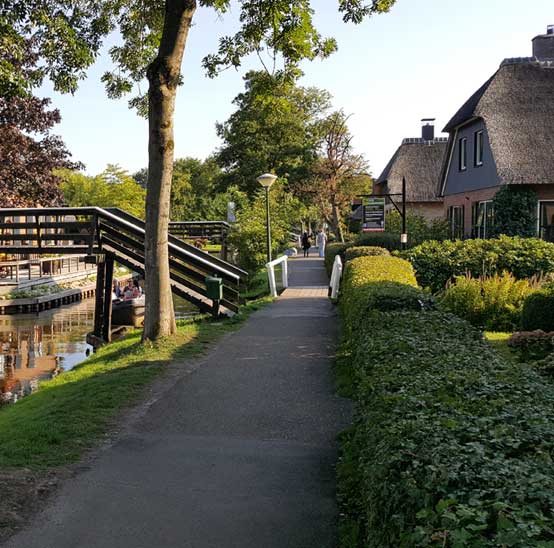Giethoorn is a village in the Dutch province of Overijssel and is located between the cities of Steenwijk and Meppel. Giethoorn belongs to the municipality of Steenwijkerland. The village has about 2800 inhabitants and is known for its bridges, canals and pontoons. It is called "Dutch Venice" or "Venice of the North". Giethoorn is elongated and consists of three neighborhoods. In the north is Noordeinde, then in the middle Middenbuurt and finally in the south Zuideinde. The Dorpsgracht canal is the central axis of Giethoorn and ends in the south at Wijde Zuideindiger. The humpback farm is characteristic for Giethoorn. The farm seems to have a hump because the barn is bigger than the house. Ponds and lakes were created by peat. To transport the peat, the channels, canals and ditches were dug. Many houses are built on islands that can only be reached by boats and bridges. Most of the almost 180 bridges are privately owned. The only connection through the old village is a bicycle and walking path that runs from north Noordeinde to south Zuideinde and is only interrupted by the Kerkweg street between Noordeinde and Middenbuurt. The main traffic in the village takes place over the water by all types of motorized boats.

The first mention of Giethoorn dates back to 1225. Previously the village was called Geythorn which means goat's horn (geyt). In the local dialect, the goat is "giet". That's how the name Giethoorn came about. Giethoorn was a settlement of peat diggers. Around 1750, the village changed from peat as a basis for livestock farming. The channels were initially dug for peat removal, but have become increasingly important for the farms. A culture of building and sailing boats was developing. In addition to livestock and peat extraction, cutting cane and other aquatic plants to cover houses and farms was also a source of income. Fishing was important in Giethoorn in the 19th and early 20th centuries. Today, tourism is also an important source of income.